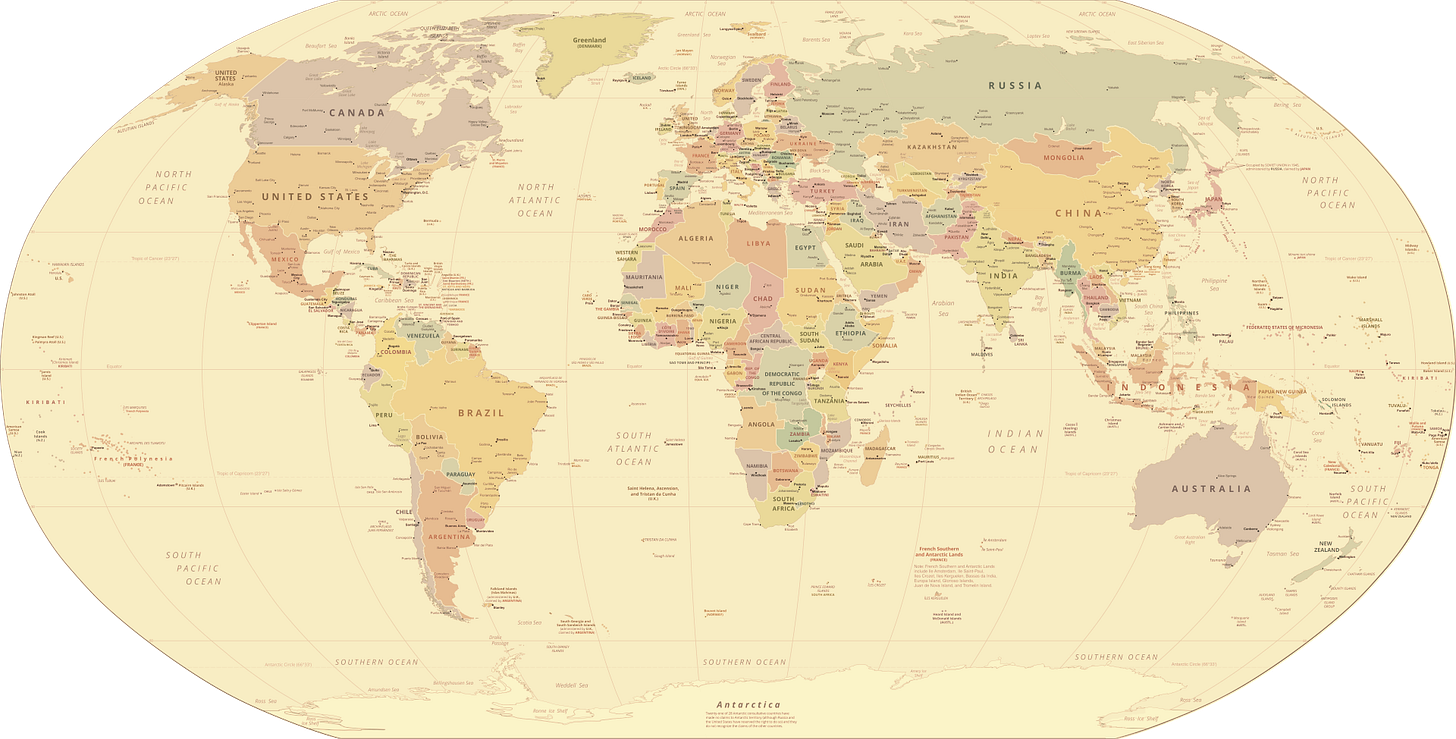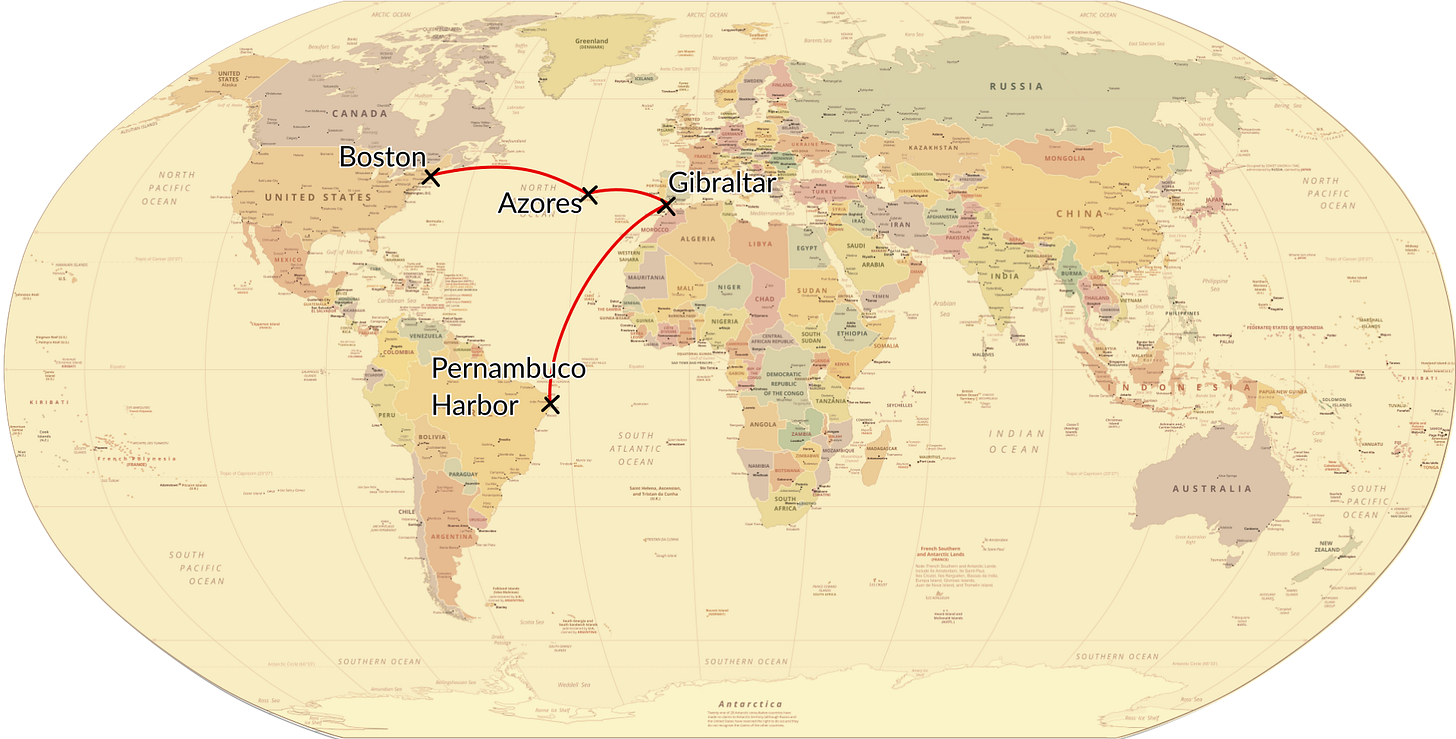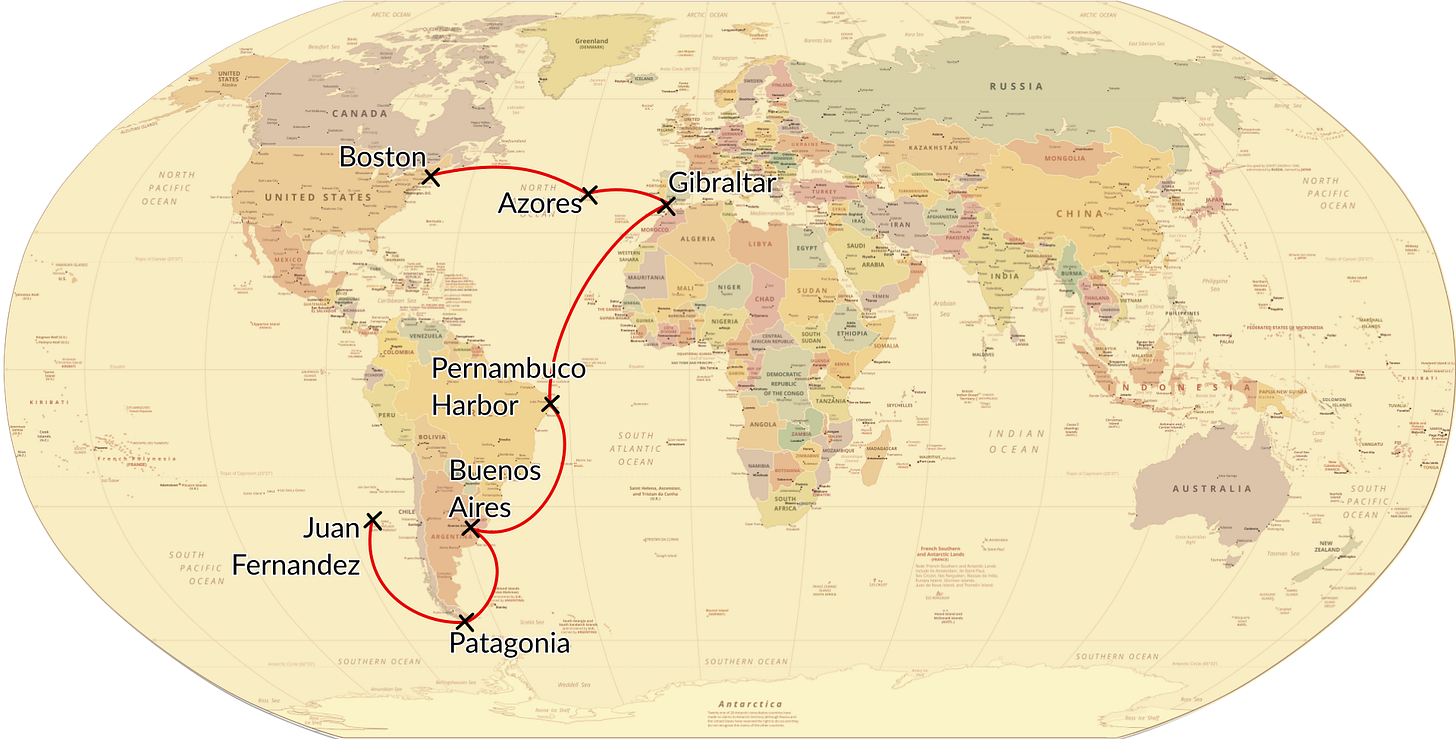Meridians is a Newsletter and Podcast featuring real stories from history. Each week, I explore a different topic connected in some way to the previous week’s topic.
Through this format, I hope to make connections through history across cultures and across the world.
Sailing Alone Around the World
The Adventures of Joshua Slocum, Part 2
In the previous article, I wrote about Joshua Slocum and his early life. He lived a full, exciting life before he ever made his famous voyage around the world alone. So, when he started off on a voyage around the world, it's safe to admit he knew what he was doing. Today, we're picking up where we left off. Slocum left Boston, Massachusetts, on the boat he built called the Spray on April 24, 1895.
Here's an excerpt from his book:
“A thrilling pulse beat high in me. My step was light on deck in the crisp air. I felt that there could be no turning back, and that I was engaging in an adventure the meaning of which I thoroughly understood. I had taken little advice from anyone, for I had a right to my own opinions in matters pertaining to the sea.”
He was a master of the sea, and he was about to prove it.
Slocum’s first stop on his voyage was Gloucester, Massachusetts. There, he told people of his voyage. They were very supportive and offered help. He was given a fisherman’s light as a present here. He also painted the bottom of the boat with antifouling paint to avoid barnacles and buildup. He also purchases a half dory to use as a raft and as a tub.
The key thing to remember about Slocum is that he's a resourceful guy. He's been described as a person who knew how to 'make-do' out of what he had. He's been shipwrecked and marooned on more than one occasion and has had to use whatever was available to get by. The same would be true for this trip.
After a few weeks of preparing and gathering supplies in Massachusetts, Slocum sets out for the Atlantic. within a few weeks, he is feeling loneliness set in. He keeps himself occupied with work and would sometimes sing to keep himself company. When he reached the Azores, he was traveling roughly 100-150 miles per day. It's July, the sun has been shining. Besides some fog he'd had a few weeks earlier, the trip was going well–until it wasn't.
Note: The maps shown are not completely accurate. They, like the rest of the article, are an abbreviated version of Slocum’s famous voyage around the world. Some minor stops have been left out.
He ran into a gale with choppy seas and large waves. To make matters worse he had become delirious from some bad plums and cheese he had eaten. He began to think boats, instead of waves, were crashing onto his deck. Apparently, he said out loud: "You'll smash your boats, but you can't hurt the Spray. She is strong !"
Twenty-nine days into the voyage, he saw Spain. He passed through the Strait of Gibraltar. He made an extended stop there and received help from a British Admiral who helped Slocum mend his sails and kept him fed. He spends a few weeks here, reading, resting, and preparing for the rest of his journey.
On August 25th, 1895, he left Gibraltar. He planned on traveling the Mediterranean and passing through the Suez Canal. But, he was made aware of pirates that frequented that area. So, instead of an eastern voyage around the world, he would head southwest to Brazil and start a western voyage around the world.
This was no small course correction. Most of the nearly 3500 miles that he traveled were in the opposite direction of his goal. This kind of thing, so early in a trip, had to be discouraging. He even encountered pirates after passing out of Gibraltar anyway. Fortunately for him, their mast tore in heavy seas. And then, from there, Slocum demonstrated his perseverance. He's starting to adjust to being alone. Forty days later, he was anchored in Pernambuco harbor in Brazil. He had a wealthy friend there who helped with provisions.
Slocum was sailing south, but the current flowed strongly to the north off of Brazil. Because of this, he had to stick close to shore. The ship ran aground. The half dory came in handy, and he used it to get ashore. And here's an odd detail about Joshua Slocum. He can't swim. The man has dedicated his life to the ocean but can't swim. Nova Scotia has plenty of beaches, lakes, and waterways. It's very odd.
Slocum is actually quite discouraged at this point. His boat is fairly damaged, and he knows he's got difficult days ahead of him. But he dusts himself off, gets some help, and gets the boat to a dock in Montevideo, Uruguay. Then, he sailed upriver to Buenos Aires and made more modifications to his boat. He shortened The Spray's mast height and also shortened the bowsprit, which is the large pole you see pointing out the front of a boat with the triangular sail attached to it. He likely did this to make his boat more stable in rough conditions. This would certainly have an impact on the ship's performance, but he probably thought the risk of wrecking was worse than the boat being a little slower.
In January 1896, he left Buenos Aires, heading south down the coast of South America. So now he's got to round the cape horn. Down there, the seas can be very scary; there are many stories of shipwrecks and tragedies in this area. Slocum knows this. Sometime around Patagonia, a great storm came. In the midst of it, he saw a giant wave coming toward him. He quickly took down the sail and climbed up into the rigging. He held tight to the sails high in the rigging. Below him, he saw only water. It was crashing everywhere over the ship, then the ship would rise out of the water only to be engulfed by the sea once more.
Imagine being this isolated. It's gloomy. You're alone on the sea on your little sailboat, trying to survive a storm by holding tight high in the mast while the boat rides on and through the waves. He admitted that he was terrified in those moments, but his experience and knowledge guided him through it. He and his boat survived the storm. From here, he was reassured in the confidence he had in his vessel and in himself, surely as well.
He does make a short stop in Patagonia, but then by March 3rd, he's heading out into the open Pacific. He's not given much reprieve. He again encounters rough seas and difficult conditions.
“Hail and sleet in the fierce squalls cut my flesh till the blood trickled over my face; but what of that?”
Clearly, he was purely driven and determined. He would be forced back the way he came by such strong winds which he could not overcome. He’s forced back to shore. He makes several attempts to launch into the Pacific, 6 in fact. In between these attempts, he's anchored and having to fight off natives who board his ship. He's shot at by arrows and has all kinds of dealings with native peoples. Some want to take his things, some want to take his boat, and some are friendly. This one little month could be considered a single adventure, but it’s a footnote in Slocum’s journey.
Finally, favorable winds in the first weeks of April give him the ability to launch into the Pacific. By April 26th he makes it to Juan Fernandez islands and moors at the port there. So now he's been at sea for roughly a year. He's about a third of the way up the coast of South America.
From there he starts making great progress in the Pacific. He makes it to the Island of Nukahiva but sails right past it. And if you look it up, you'll see that he's in the middle of the Pacific now. He's got to be about as far from his culture and populated civilization as one can get.
Twenty-nine days later, on July 16th, he makes it to Apia, on the Island of Samoa. And visiting the Samoans he seems to kind of reflect on society. The farther he gets away from society, the happier he seems to be. Back home everyone is in the fervor of the capitalist mindset. These places he's visiting couldn't have a more different mindset. They were simply living, and he admired them for that.
He spends about a month in Samoa before he sets off. After 43 days of storms and gales, he arrives in Sydney, Australia. Then he heads down the west coast of Australia and makes his way to Melbourne and heads to port. Melbourne's ports charge tonnage fees, and he wasn't able to get out of paying them with his charm, apparently. So he made a bit of a spectacle of his boat and let people come aboard for a small fee. Then he caught a large shark and charged people to look at it. This was Slocum doing what he did. He 'made-do' with whatever he could.
He made his way out of Melbourne and headed south to Tasmania. This makes it crystal clear, if it wasn't already, that this trip wasn't about going around the world as fast as one could. This was really more of a world tour, the trip of a lifetime, but you might say it's one of the greatest trips of all time. Few could say they've done what he's done up until this point.

He bounced around Australia for several months. Eventually, after a few delays and a few encounters, he left the coast of Australia and headed west. He made his way to the Indian Ocean. He's making 130 miles per day, and by July 17th, 1897, he lands at Keeling Island.
Being the world traveler that Slocum was, it seems like he became a great communicator. He made friends wherever he went. It would be easy to overlook, but I think one of Slocum's greatest characteristics is his ability to embed himself and endear himself to wherever his boat came to port. This is like a superpower for a sailor. Everywhere he went, he received help. He learned about the people on the island, and they were very interested in him as well.
He made it to the Cape of Good Hope off the Southern coast of Africa on Christmas day, 1897. He stopped off at Cape Town and spent several months there. He even met the president of South Africa, who insisted to Slocum that the world was flat. This had to be a somewhat amusing encounter, particularly for a man traveling AROUND the world.
In March, he leaves South Africa and, by April 16th, makes his way to Saint Helena, the final Island on which Napoleon had been exiled and eventually died, only less than 80 years prior. In Slocum fashion, he made the rounds, soaking up everything. He visited with the Governor, gave lectures about his travels, and, of course, visited the home of Napoleon.
He crosses an important point in May of 1898. He made it across a point he'd been at in October of 1895.
"… I felt a contentment in knowing that the Spray had encircled the globe, and even as an adventure alone I was in no way discouraged as to its utility, and said to myself, "Let what will happen, the voyage is now on record."
From here, he let the current carry him up the coast of Brazil. The same current he ran aground fighting against three years prior. By May 22nd, he arrives in Grenada. From there, he made his way north, and on June 27, 1898, he cast anchor in Newport Harbor in Rhode Island, which is straight south of Boston. He had traveled over forty-six thousand miles around the world during a time of three years and two months. He said that after the voyage, he felt 10 years younger than the day he had felled the first tree to build the Spray.
Slocum had used simple tools on his ship and had navigated without the use of a chronometer. Instead, he used traditional methods such as dead reckoning and celestial navigation, which had been employed for hundreds of years. He had proved his mastery at sea as a sailor and became a maritime legend.
When Slocum published his book "Sailing Alone Around the World," in 1900, it was an immediate success. Though it sold well, It wasn't the most financially successful book for Slocum. He didn’t get rich. However, he was able to settle down and buy a small farm in West Tisbury, Massachusetts, with his earnings from it.
Slocum would make another voyage years later, but it would end up being his last. He left Martha's Vineyard on November 14, 1909, aboard the Spray. He had intended to explore South America's Orinoco and Amazon rivers. He was never seen or heard from again after his departure. No one actually knows what happened to him. Neither his boat nor he was ever found.
Dear Reader:
Personally, I ask you this. Does it do anyone harm to imagine that Slocum simply left and kept sailing? He was 64 years old when he last left Massachusetts. As ridiculous an idea as it probably is, I'll reserve my right to believe he may have sailed on for years alone, having said goodbye to his life in New England and resigned himself to sailing out the rest of his days.
After Slocum's legendary voyage, he said this about his trip:
"one does not need to be a rich man to undertake such a voyage, and one doesn’t need a “sponsor”. “To succeed, however, in anything at all, one should go understandingly about his work and be prepared for every emergency. I see, as I look back over my own small achievement, a kit of not too elaborate carpenters' tools, a tin clock, and some carpet-tacks … But above all to be taken into account were some years of schooling, where I studied with diligence Neptune's laws, and these laws I tried to obey when I sailed overseas; it was worth the while.”
Meridiots: Book 1, Episode 2: New Crew Arrive
Meridiots is a serial comic about a group of misfits at sea. They’re going to travel the world and try to understand humanity. Hopefully, with a strong helping of my most idiotic sense of humor, it can resonate with someone!
Book 1 is the introductory book. It’s a learning process for me, so there might be slight changes in design over the next few months.
Hey, you! don’t be a stranger.
“Lighten up, Francis”
-Sergeant Hulka, Stripes
Recommendations
The Demon of Unrest: A Saga of Hubris, Heartbreak, and Heroism at the Dawn of the Civil War
I’m only halfway through this book, but so far, it has really painted a picture of the mindset of a Southern slaveholder. The book is a really good reminder of the mental gymnastics people will go through to preserve their way of life.
Notes
I would have loved to have read all of Slocum’s book “Sailing Alone around the World” before writing this article, but the way I do my research, the time I have, and my personal need to publish every week, forces me to do research in a more abbreviated fashion. I may return to this article and update it as time goes on if only to add important details or correct any small inaccuracies.
I look at this newsletter as my own personal schooling. I’m no sailor but rather a student of history and a student of writing. Some day, I hope to have worked as hard and as passionately as Slocum did to make a great epic creation of some kind. Until then, I’ll be here working. Thanks for reading today!
Links
Spotify | Apple | Podcast Addict | Pocket Casts | YouTube




















